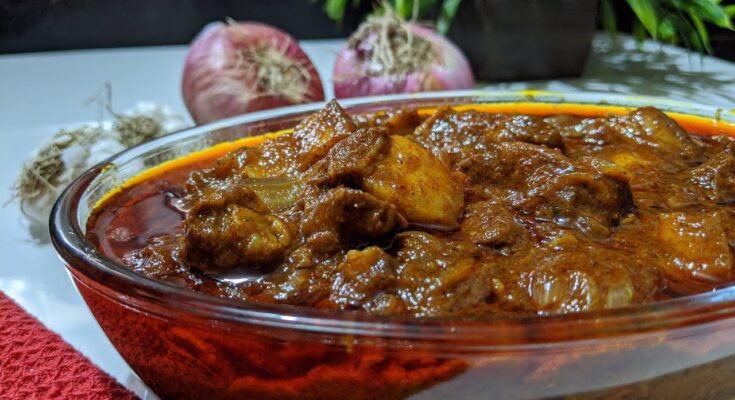Vindaloo Recipe: Vindaloo is a fiery, tangy, and flavorful curry dish that has earned legendary status in Indian and Goan cuisine. Originally derived from the Portuguese dish “Carne de Vinha d’Alhos” (meat marinated in wine and garlic), Vindaloo has been completely transformed by Indian spices and cooking techniques. What makes Vindaloo stand out from other curries is its balance of heat, tanginess, and slightly sweet undertones. It’s known for its signature red hue, bold flavors, and a heat level that can be adjusted to taste—making it a favorite for spice lovers worldwide.
Unlike many Indian curries that rely heavily on cream or yogurt bases, Vindaloo is vinegar-based, giving it a unique zing that cuts through the richness of the meat. Traditionally, it’s made with pork, but chicken, lamb, beef, or even tofu versions are widely embraced. The dish is a popular feature in both home cooking and restaurant menus, especially in British-Indian cuisine where it’s often used as a benchmark for spice tolerance.
So whether you’re a die-hard curry fan or a curious foodie ready to dive into something bold and robust, this Vindaloo recipe is your gateway to a culinary adventure.
Origin and Cultural Background
The roots of Vindaloo can be traced back to the 15th century when Portuguese explorers introduced the dish to Goa, a coastal state in India. Originally, “Carne de Vinha d’Alhos” was a simple preparation of pork marinated in wine and garlic. When this dish made its way to India, local chefs began adapting it using indigenous spices, substituting wine with palm vinegar, and adding ingredients like chili, cumin, and cinnamon.
Over time, Vindaloo evolved into a staple of Goan cuisine, cherished for its complexity and versatility. During the colonial period, this fusion dish continued to spread and was later embraced by Anglo-Indian cuisine. In Britain, it became synonymous with one of the spiciest curry options on the menu—sometimes exaggerated to extremes.
Despite its reputation for intense heat, authentic Vindaloo is more than just a fiery challenge—it’s about depth of flavor, blending heat with acidity and a subtle sweetness. This heritage makes Vindaloo not only a tasty meal but also a culinary symbol of cross-cultural fusion.
Ingredients Needed
Key Spices and Marinade Ingredients
To make an authentic Vindaloo, you’ll need a powerful blend of spices that deliver layers of flavor. Here are the essentials for the marinade and curry:
- Cumin seeds – 1 tsp
- Coriander seeds – 2 tsp
- Cinnamon stick – 1 small piece
- Cloves – 3-4
- Black peppercorns – ½ tsp
- Turmeric powder – 1 tsp
- Smoked paprika – 1 tsp
- Red chili powder – 1-2 tsp (adjust for heat)
- Ginger-garlic paste – 2 tbsp
- White or malt vinegar – 3 tbsp
- Brown sugar – 1 tbsp
- Salt – to taste
These spices will be roasted, ground, and mixed with vinegar and sugar to create a tangy, aromatic marinade. The combination of sweet, sour, and spicy is what sets Vindaloo apart from other curries.
Main Ingredients for the Dish
Once your spice base is ready, it’s time to bring in the main components. Here’s what you need:
- Pork shoulder or belly (cubed) – 500g (can substitute with chicken, beef, or tofu)
- Onions (finely chopped) – 2 large
- Tomato puree – 3 tbsp
- Oil or ghee – 2-3 tbsp
- Water or stock – as needed for consistency
The choice of meat can significantly influence the final taste. Pork offers a rich, fatty texture that soaks up the marinade beautifully, but leaner meats like chicken or lamb also work well. For a vegetarian version, tofu or tempeh makes an excellent substitute.
Optional Add-ons for Enhanced Flavor
While the basic Vindaloo is already packed with flavor, here are a few extras that can elevate it further:
- Mustard seeds – add a nutty aroma
- Bay leaves – for subtle bitterness
- Curry leaves – for a South Indian twist
- Fresh chopped coriander – for garnish
- Potatoes – sometimes added to stretch the dish
These additions can personalize your dish to suit your preferences, whether you’re aiming for a restaurant-style curry or a comforting homemade meal.
Equipment Required
Kitchen Tools You’ll Need
Having the right tools makes the cooking process smoother and more enjoyable. Here’s a checklist of what you’ll need:
- Heavy-bottomed pot or Dutch oven – for even cooking and simmering
- Blender or spice grinder – to make a smooth paste
- Knife and chopping board – for prep work
- Mixing bowls – for marinating the meat
- Wooden spoon or spatula – for stirring without scratching the pot
- Measuring spoons and cups – for accuracy
While Vindaloo isn’t overly complicated to make, precision in spice measurement and slow cooking are crucial. A sturdy pan ensures the spices don’t burn, while a good blender helps create a uniform marinade that coats the meat thoroughly.
Preparing the Vindaloo Marinade
How to Make the Marinade
The heart of a Vindaloo lies in its marinade. Start by dry roasting the whole spices—cumin, coriander, cloves, peppercorns, and cinnamon—until fragrant. This releases the oils and intensifies their flavors. Once cooled, grind them into a fine powder.
In a bowl, mix this spice blend with ginger-garlic paste, vinegar, paprika, chili powder, turmeric, brown sugar, and salt. You should get a thick, aromatic paste. This combination is what gives Vindaloo its signature flavor—punchy, tangy, and bold.
You can make the paste ahead of time and refrigerate it for a day or two. In fact, aging the paste slightly enhances the flavor. If you’re short on time, store-bought Vindaloo paste can work, but the homemade version always wins on freshness and authenticity.
Marinating the Meat Properly
Take your meat cubes and coat them generously with the prepared marinade. Use your hands to massage the paste into every nook and cranny. Once done, cover the bowl and refrigerate for at least 4 hours—overnight is best for deep flavor infusion.
This step isn’t just about adding taste; it also tenderizes the meat, especially if you’re using tougher cuts like pork shoulder. The vinegar breaks down the fibers, while the spices seep in to create a flavor bomb in every bite.
Cooking the Vindaloo
Frying the Base
Once the meat is marinated and ready to go, it’s time to start cooking. Heat 2 to 3 tablespoons of oil or ghee in a heavy-bottomed pot or Dutch oven over medium heat. Add finely chopped onions and sauté them until they turn golden brown. This step is crucial—don’t rush it. Properly browned onions are the secret to a rich and flavorful curry base.
As the onions begin to caramelize, they release sugars that balance the tangy and spicy notes of the Vindaloo. If you’re using mustard seeds or bay leaves, toss them in at this stage to release their aromatic oils. Stir continuously to prevent burning, and keep the heat controlled.
Once your onions are perfectly browned, add the tomato puree. Cook it until the oil begins to separate from the mixture, which is a sign that your curry base is well-cooked. This step deepens the flavor and ensures the dish won’t taste raw or acidic from the tomatoes.
Adding the Marinated Meat
Now it’s time for the star of the show: the marinated meat. Remove it from the fridge and allow it to come to room temperature for about 10-15 minutes before cooking—this ensures even cooking. Add the marinated meat into the pot with the onion-tomato mixture.
Sear the meat on medium-high heat until it browns on all sides. This seals in the juices and caramelizes the sugars from the marinade, intensifying the flavor. Stir well so the marinade doesn’t stick to the bottom. If you notice sticking or burning, deglaze the pot with a splash of water or stock.
At this point, your kitchen will smell heavenly—spicy, savory, and deeply aromatic. The combination of roasted spices, vinegar, garlic, and browned meat creates a symphony of scents that’s hard to resist.
Simmering for the Perfect Consistency
Once the meat is browned, it’s time to add water or stock—just enough to cover the meat. Bring it to a boil, then reduce the heat to low and cover with a lid. Let the Vindaloo simmer gently for 45 minutes to an hour (or longer for tougher cuts like pork shoulder).
During this time, the meat will become tender, and the sauce will thicken and develop a deeper flavor. Stir occasionally to prevent sticking. If you find the curry getting too thick, add a splash more water. If it’s too watery, simmer uncovered to reduce.
By the end of the cooking process, the sauce should coat the meat thickly, and the meat itself should be fork-tender. Taste and adjust salt, sugar, or chili as needed. Remember, Vindaloo should have a balance of spicy, tangy, and slightly sweet flavors—not just heat.
Serving Suggestions
Best Side Dishes
Vindaloo is a bold dish, so it pairs well with neutral, calming sides that balance out its fiery intensity. Here are some great accompaniments:
- Steamed Basmati Rice: The most traditional and effective pairing. Its fluffy texture absorbs the sauce beautifully.
- Naan or Paratha: Soft, buttery Indian breads that can scoop up the curry and offer a mild contrast to the spice.
- Jeera Rice (Cumin Rice): Adds a subtle flavor twist without overpowering the main dish.
- Plain Yogurt or Raita: Cooling agents that soothe the palate—especially helpful for those sensitive to heat.
- Pickled Onions or Mango Chutney: Offer a sweet and tangy contrast that complements the acidity of the dish.
With a well-paired side, Vindaloo becomes not just a meal but a full culinary experience.
Beverage Pairings
You might not think of pairing wine or beer with Indian food, but Vindaloo opens the door to some interesting combinations:
- Beer: Go for a chilled lager or wheat beer. These cut through the spice and refresh the palate.
- Red Wine: A fruity Syrah or Zinfandel pairs well, offering bold flavors without clashing.
- White Wine: Try a slightly sweet Riesling or Gewürztraminer—they can balance the vinegar and spice beautifully.
- Non-Alcoholic: A chilled mango lassi or sweet lime soda provides cooling relief and adds a tropical vibe.
Pairing the right drink can turn a good meal into a great one, especially with a dish as bold as Vindaloo.
Tips for Perfect Vindaloo
Adjusting the Heat Level
Not everyone enjoys fire-breathing levels of spice—and that’s okay. One of the best things about making Vindaloo at home is controlling the heat to your liking. Here’s how:
- Use less chili powder or opt for Kashmiri chili powder, which offers vibrant color without too much heat.
- Add yogurt or cream toward the end to mellow the dish slightly.
- Incorporate more sugar or tomatoes to balance intense spice.
- Serve with dairy-based sides like raita or yogurt to counteract the burn.
Vindaloo is supposed to be bold, but that doesn’t mean it has to be painful. Find your sweet spot and enjoy the full range of flavors.
Meat Substitutions and Vegetarian Version
Although pork is traditional, Vindaloo is incredibly flexible:
- Chicken: Quick to cook and widely loved. Use thighs for juiciness.
- Lamb: Great for depth of flavor—especially cuts like shoulder.
- Beef: A hearty, satisfying version often found in the UK.
- Tofu or Tempeh: For vegetarians, marinate tofu in the same spices for an equally flavorful version.
- Mushrooms and Paneer: Meaty mushrooms or cubes of Indian cheese hold up well in the spicy sauce.
No matter what protein or substitute you choose, the key lies in the marinade and slow cooking process.
Common Mistakes to Avoid
Overcooking or Undercooking the Spices
One of the most common pitfalls in making Vindaloo is not treating the spices properly. Spices are the soul of this dish, and mishandling them can lead to a bitter, burnt, or flat-tasting curry. Here’s how to avoid these mistakes:
- Don’t burn the spices during dry roasting. Always keep the flame on low and stir constantly. As soon as the aroma is released and they turn slightly darker, remove them from heat.
- Cook the spice paste thoroughly with onions and tomatoes. If you add it too late or don’t give it time to integrate, the flavors won’t develop fully. Look for the oil separating from the mixture as your cue.
- Avoid raw-tasting garlic or ginger. If you’re using fresh paste, make sure it’s sautéed until the raw smell disappears. This is crucial for a rich, well-rounded flavor.
Mastering this technique ensures your Vindaloo is full of depth rather than dominated by one overpowering spice.
Skipping the Marination Time
Vindaloo’s distinct flavor comes from the long marination of meat in a spice-vinegar mixture. Rushing this step is like skipping the most important act in a play.
- Why marination matters: The acidic vinegar helps tenderize the meat while infusing it with complex spice notes. The longer the meat sits in the marinade, the more intense and integrated the flavors become.
- Minimum time: At least 4 hours is necessary for a decent infusion.
- Optimal marination: Overnight in the fridge (8–12 hours) allows the meat to soak up every ounce of flavor.
If you’re in a real hurry, consider marinating smaller meat pieces for faster absorption, but ideally, plan ahead and give it time. Trust us, the difference in taste is well worth the wait.
Storing and Reheating Leftovers
How to Store
Made a big batch? Great! Vindaloo stores beautifully and often tastes even better the next day. Here’s how to keep it fresh:
- Refrigerator: Let the curry cool completely before transferring it to an airtight container. It can be stored in the fridge for up to 4 days.
- Freezer: For long-term storage, place Vindaloo in freezer-safe containers or bags. It will last for up to 3 months without losing its flavor.
- Pro Tip: Portion out the curry before freezing. This way, you can reheat only what you need, saving time and reducing waste.
The flavors deepen as the dish rests, so leftovers are often more delicious than the first day’s serving.
Best Reheating Methods
When you’re ready to eat the leftovers, reheating it right ensures you retain that bold Vindaloo taste:
- Stovetop: The best method. Warm it on low heat in a pan with a splash of water to loosen the sauce and prevent sticking.
- Microwave: Heat in short bursts, stirring between each one to ensure even warmth throughout.
- Oven (for big portions): Place the curry in an oven-safe dish, cover with foil, and heat at 350°F (175°C) for about 15–20 minutes.
Avoid reheating repeatedly as it may dry out the meat or intensify the acidity.
FAQs about Vindaloo Recipe
Q1. What is Vindaloo?
Vindaloo is a spicy, tangy Indian curry originally inspired by a Portuguese dish called “carne de vinha d’alhos.” It’s typically made with pork, but chicken, lamb, or even vegetables can be used.
Q2. Is Vindaloo very spicy?
Yes, Vindaloo is known for its heat. However, the spice level can be adjusted by reducing the amount of chili or using milder peppers.
Q3. Can I make Vindaloo ahead of time?
Absolutely. In fact, Vindaloo tastes even better the next day as the spices continue to develop. Just store it in the fridge and reheat when ready to serve.
Q4. What should I serve with Vindaloo?
Vindaloo pairs perfectly with steamed basmati rice, naan bread, or roti. A side of cooling yogurt or cucumber raita also balances the heat.
Q5. Can I freeze Vindaloo?
Yes, Vindaloo freezes well. Store it in an airtight container for up to 3 months. Defrost in the fridge overnight and reheat thoroughly before eating.
Q6. Is Vindaloo gluten-free?
Most homemade Vindaloo recipes are naturally gluten-free. Just ensure your spice mixes and vinegar are free from gluten-containing additives.
Final Thoughts
Making Vindaloo at home is not just about cooking a curry—it’s about embracing a rich culinary tradition that blends spice, history, and soul. From its Portuguese-Goan origins to its modern-day adaptations, Vindaloo is a dish that tells a story in every bite. With the right spices, a good marinade, and a little patience, you can turn a few humble ingredients into a feast fit for any occasion.
Whether you like it burning hot or mellowed down, meaty or meatless, Vindaloo is a recipe that adapts to your taste while keeping its fiery spirit intact. So next time you’re in the mood for something bold, skip the takeout and create your own Vindaloo masterpiece at home.



